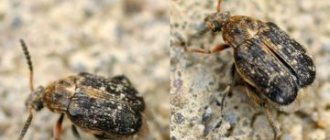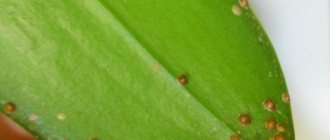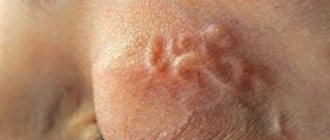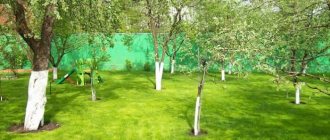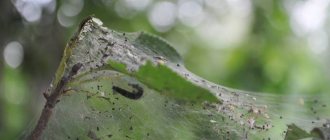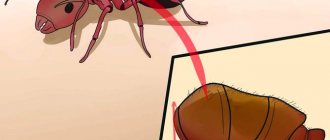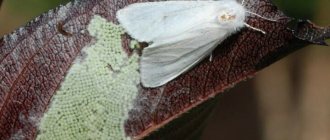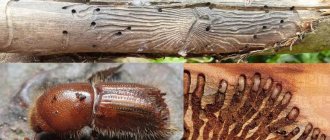Greetings, dear friends! In today’s article I want to tell you how to care for viburnum in the fall so that next year it will please us with an abundance of healthy berries.
The variety of varieties of viburnum can surprise even experienced gardeners. It's hard to believe, but the color of the berries can even be black. We loved this berry for its beauty and interesting taste. It bears fruit in late summer, and the harvest is stored until autumn, which exposes the plant to attack by birds that are preparing for the winter.
When cold weather sets in, the unusual carved foliage of the tree takes on a special beauty: it glows with tints of orange and red, which highlights the scarlet berries.
Black aphid
As soon as the first buds on the viburnum bloom, the black (viburnum) aphid occupies the young shoots. Deprived of vital juices, young leaves become deformed and curl. Dark spots of various shapes appear on them, which leads to complete drying and death of young branches. In one season, several generations of aphids appear, and the first is equipped with wings - it has the ability to move from bush to bush, capturing all plants, not just viburnum.
The last generation overwinters at the base of the bush and, at the first signs of the beginning of spring, rushes along the trunks, getting closer to the buds that are beginning to swell. That is why active pest control begins in early spring.
The viburnum aphid causes damage to the entire area, but the main habitat is viburnum bushes. All the main means of struggle are used on them.
There are two main stages in the fight against black aphids.
- Creating the most unfavorable conditions for laying eggs of the last, wintering generation. To do this, you have to cut out without regret all the basal shoots, which abound in viburnum bushes. It is optimal to carry out such thinning of the base of bushes in the second half of summer.
- Spring treatment of bushes against pests using chemicals or folk remedies.
In the first days of spring, before using any pest control, the trunks of viburnum bushes are cleared of exfoliated old bark - most pests hibernate under it. After all the debris has been removed, the ground under the bush is watered with hot water.
Application of pesticides
The first treatment is carried out as soon as the spring sun warms up. During this period, pests emerge from hibernation and begin moving towards the kidneys. The most effective drugs include:
- "Aktara";
- "Decis";
- "Prestige";
- "Karbofos";
- "Fufanon."
All of them contain either neonicotinoids or organic phosphorus. They are also applicable in the fight against other viburnum pests - sawflies, gall midges, and viburnum leaf beetle. Prepare working solutions in accordance with the manufacturer's instructions.
Viburnum should be sprayed against pests in dry, windless weather using personal protective equipment.
Good results are obtained by treating viburnum with a Nitrafen solution at the rate of 200 g of product per 10 liters of water. The drug also needs to be sprayed on the homes of ants that carry aphids.
It is permissible to poison pests with chemicals only in early spring, since later application will harm pollinating insects, especially bees.
Folk remedies
The fact that folk remedies are less effective in combating aphids is a fairly common misconception. Their effectiveness is no lower than industrial pesticides if they are prepared and applied according to all the rules. At the same time, solutions prepared according to “grandmother’s” recipes can be used throughout the entire growing season. But it is better not to wait until the pest has firmly established itself on the viburnum, but to spray the affected plants immediately after detecting the pest.
- Soap solution
Prepared from laundry or green soap - 300 g per bucket of water. The treatment is carried out 2-3 times a week, after washing the bush with water from a hose under moderate pressure. Instead of soap, you can use one of the most inexpensive washing powders.
- Ash infusion
A glass of ash is brewed with a liter of boiling water and left for a day. Then add 40-50 g of soap or washing powder, bring the volume to 10 liters. Spray viburnum once a week.
- Ammonia
The solution is prepared from 20 ml of alcohol and a bucket of water. Viburnum is treated against pests twice, less often - three times, the interval between spraying is 2 weeks.
- Tobacco infusion
250 g of tobacco or shag are infused in 5 liters of water for 2 days. Then filter, add 5 liters of water and treat the bushes.
- Pharmaceutical chamomile
Take 1 kg of dried flowers in a bucket of hot water and leave for 12 hours. Strain the infusion, add 2 parts water to 1 part infusion. The plants are treated with the prepared solution immediately after mixing.
- Pyrethrum (Caucasian chamomile)
300 g of crushed dried flowers are poured with a small amount of boiling water, left for 2 hours, filtered, water added to 10 liters and immediately sprayed with viburnum - the herb successfully fights many pests of garden crops.
Dried pyrethrum flowers can be purchased at pharmacies or garden centers under the trade name Persian Powder. The manufacturer indicates recommendations for use on the packaging.
- Needles
Pine or spruce needles are crushed and steamed with boiling water at the rate of 200 g of dry raw material per liter of water. The infusion is kept tightly sealed for two days, after which the affected bushes are sprayed with it.
- Henbane black
If there are thickets of this plant nearby, take young rosette leaves (about 200-300 g), pour a bucket of hot water and leave for 13 hours. Before spraying, add 30-50 g of liquid soap to the infusion.
Black henbane is a poisonous plant; be careful when working with it.
Features of viburnum
The plastic plant is unpretentious and can adapt to a wide temperature range, any soil except sandstone or wetlands. Among other cultivated plants, it is distinguished by its rare and priceless qualities.
Medicinal properties
All parts of viburnum are used for medicinal purposes in folk and classical medicine. Berries contain a rich set of microelements, biologically active substances and large amounts of vitamins E, K, P, A. They contain 3 times more vitamin C than lemon.
The bitterness of viburnum fruits comes from viburnin, which exhibits analgesic properties. The substance normalizes the function of the digestive tract and liver, activates the immune system, and narrows the lumen of blood vessels.
Berry infusion calms the nervous system, relieves headaches, eliminates swelling, and relieves symptoms of diathesis in infants. An infusion of flowers, bark and leaves treats gastritis associated with decreased production of hydrochloric acid and painful periods.
Fruit consumption should be limited in case of urolithiasis, arthritis, increased stomach acidity, gout, or low blood pressure.
High growth rates
In two years, a small plant grows into a full-fledged bush, so viburnum is widely used to create hedges, landscaping areas and quickly improving a new area.
Professional products
If the viburnum is attacked by aphids, you can fight it with professional chemical preparations based on insecticides. The active components of the product block nerve impulses, causing paralysis and early death. The minimum dose of poison is enough to cause death.
The advantages of this method of control are high efficiency, quick results, preservation of properties for up to 20 days. The insecticidal agent destroys adults and larvae of all ages.
Insecticides for insect pests
The drug is sold as a concentrate. Before use, you should prepare a solution by diluting it in a certain amount of water. Usually 10 l. While working, you must wear rubber gloves and carry out the procedure in the morning and evening in dry, windless weather.
The most effective means:
- Aktellik;
- Karbofos;
- Prestige;
- drug Aktara;
- Fufanon;
- insecticide Fitoverm;
- drug Iskra;
- Decis;
- Tanrek product;
- Inta-Vira.
Which drug to use is an individual decision. All of them act immediately, mass death of aphids is observed within a week, and retain their properties for up to 20 days.
On a note!
Before the buds open, it is recommended to treat all shoots with Nitrafen paste. You can treat viburnum against aphids during flowering using any insecticidal spray method.
Insect pests of viburnum
Black viburnum leaf roller aphid
The black viburnum leafroll aphid (Aphis viburni) is a small sucking insect of dark brown, black color. It lays eggs on the bark of branches near the buds, where they overwinter. When the leaves bloom, the first generation larvae emerge from the eggs. This insect pest of viburnum feeds on the sap of young leaves; when the pest population is large, the leaves curl and dry out.
Control measures. Spray viburnum bushes against aphids with one of the following preparations: Fufanon, Inta-Vir, Fitoverm.
Viburnum leaf beetle
The viburnum leaf beetle (Galerucella viburni) is a light brown beetle. The larvae are greenish-yellow, with a black head and black spots on the back. In May they feed on young leaves, roughly eating them. In early June, the larvae pupate in the soil. After 3-4 weeks, beetles appear and eat leaves, shoots and berries. In August, females gnaw holes in young shoots and lay eggs in them, covering them with lids.
Control measures. Trim dead shoots containing egg-laying plants. To combat these viburnum pests, you need to spray the bushes in May, when the larvae hatch, or in early August, when the beetles appear, with the following preparations: Fufanon, Iskra, Inta-Vir, Actellik and Kemifos.
Video: Treatment of Viburnum from pests
Control measures. Spraying plants before flowering with 10% karbofos (75-90 g per 10 liters of water). During the growing season, treatment with pepper infusion (1 kg of pods cut in half or 0.5 kg of dry crushed fruits per 10 liters of water), tomato shoots (4 kg of green or 1 kg of dried mass per 10 liters of water) or pharmaceutical chamomile (3 kg of green or 1 kg of dried mass per 10 liters of water).
Viburnum leaf roller
Damages viburnum and mountain pine. The caterpillar is dark bluish-gray or olive-green, yellowish on the sides, covered with light hairs, and the head is light brown. Caterpillars that hatch in the spring eat the buds and later damage the leaves, entwining them with cobwebs and knocking them into a ball. They pupate in mid-summer in feeding areas. With massive development, the viburnum leaf roller destroys many leaves, which leads to a decrease in yield.
Control measures. Collecting and burning nests with caterpillars. Spraying before buds open with 60% nitrafen paste (200-300 g per 10 liters of water). Treatment of plants from the beginning of buds to the appearance of buds with 10% karbofos (75-90 g per 10 liters of water).
Honeysuckle spiny sawfly
Damages viburnum, decorative and edible honeysuckle. The body of the larva is olive-colored with two transverse rows of white spines, the back has a dark marble or mesh pattern, the sides are light gray, and the head is yellow. False caterpillars overwinter in the surface layer of soil. They pupate in the spring. Adults appear during the leaf out period. Females lay eggs on leaves. The hatched larvae feed on the leaves, eating them around the edges. If the damage is severe, young plants may become completely bare.
Folk recipes
Folk remedies for aphids
The fight against aphids on viburnum is carried out by all known methods. Folk remedies are very diverse and unique, making it possible to do without chemicals.
- In order to save the viburnum and completely overcome black aphids, it is necessary to cut out the shoots that are located at the roots in late autumn. It is in this place that the aphid lays eggs and leaves them to overwinter. In the spring, when the bush begins to bloom, pour hot water onto the soil at the root.
- Natural enemies of insects - ladybugs, lacewing larvae, and hoverflies - can destroy aphids.
- You can spray viburnum with a solution of onion peels. Pests cannot stand this smell and try to escape from it as quickly as possible. 200 g of husk is combined with 500 g of wood ash, 200 g of tobacco powder. Pour in 10 liters of water. Leave to infuse for 5 days. Before use, add laundry soap and filter the finished product. It is necessary to spray viburnum in May even before the first leaves bloom, or during the flowering period. Repeat the procedure every week until the pests disappear.
- Wood ash, spices - cinnamon, red and black pepper, and soap solution are added to the water. Pour the mixture into a spray bottle or spray bottle. The first time you need to spray the viburnum is in the spring, then this should be done every month with a break of 7-14 days.
- You can get rid of aphids with a strong tincture of garlic, tobacco, and pine needles. They can be used together or separately. 200 g of raw materials are poured into 1 liter of water and boiled for half an hour. Cover with a lid and leave for 5 days. Strain the finished preparation and add soap. Spraying is carried out.
- Grind potato tops, tomato tops or marigolds. Pour 10 liters of water and boil for half an hour. Leave for at least a day. Viburnum is sprayed every 3 days during active control. For prevention, once every 2 weeks. It is allowed to prepare the product in reserve. The longer it sits, the greater the concentration of active components.
On a note!
Aphids on viburnum buldenezh are exterminated by the same means. This is an ornamental bush 3 m high with beautiful buds of white flowers that adorn the bush in May.
Also used against aphids:
- ammonia;
- soda;
- milk and iodine;
- vinegar;
- celandine;
- mustard;
- vodka;
- green soap;
- Birch tar;
- boric acid.
The most common pests
Viburnum has many admirers not only among people, but also among insects. However, the preferences of the latter are destructive for her. The following are the pests that can cause the greatest harm to viburnum, as well as how to get rid of them and save the plant.
Black aphid on viburnum, how to fight
These small bugs are easy to notice: they are brown, almost black in color (less often crimson-brown) and accumulate in large quantities on the stems of the plant. They usually lay eggs in the bark of the viburnum tree, as well as on the branches. In the spring, the larvae hatch, begin to suck out the juices and eat the young leaves of the plant. Over time, they dry and curl, and the shoots change shape.
In general, aphids attack three times a year, starting in May. During this month it is necessary to start treating the plant with insecticides. Then the aphid larvae grow and turn into flying insects that are able to fly to neighboring plants. In August, aphids begin laying eggs, which can successfully overwinter, despite the frost.
Black aphid on viburnum
Measures to combat viburnum aphids include the destruction of root shoots, where the largest number of eggs are laid. How can you treat viburnum against aphids? The plant should be sprayed with chemicals:
- Fitoverm,
- Akarin or Agravertin CE,
- Aversectin,
- Intavir.
It is also a good idea to treat the plant with a solution of laundry or tar soap.
Important! It is better to do the first treatment before the buds open, this will help reduce the number of overwintered eggs. What to do if the use of chemicals in a given location is not possible? Folk remedies will help
For spraying, you can use decoctions prepared from other plants. Potato tops (1.2 kg of green per 10 liters of water), pepper infusion (1 kg of capsicum per 10 liters), celandine (3-4 kg of fresh celandine per 10 liters) are suitable for this.
What to do if the use of chemicals in a given location is not possible? Folk remedies will help. For spraying, you can use decoctions prepared from other plants. Potato tops (1.2 kg of green ones per 10 liters of water), pepper infusion (1 kg of capsicum per 10 liters), celandine (3-4 kg of fresh celandine per 10 liters) are suitable for this.
It will also be useful to purchase or attract beneficial insects that destroy aphids on viburnum. This is a ladybug, a hoverfly or a goldmine larva. The insects will eat the pests, but the viburnum will not be touched.
Green lobed moth
The caterpillar has a yellow-green color with a dark red stripe along the body, the same dots and spots. Prefers to eat exclusively flowers and gnaw out flower ovaries. Particularly active between May and July. Over the summer, two generations of butterflies may appear. The moth is most often found on the ornamental shrub Buldenezh. In addition to viburnum, it can also harm other garden shrubs, such as lilac and buckthorn.
On a note! Pest control must be carried out twice: in the spring, before the viburnum begins to bloom and after it has finished. 10% Karbofos is suitable for processing.
Preventive actions
To prevent the appearance of aphids on viburnum, every spring you need to clean the bush of old peeling bark, under which there may be masonry, and whitewash the trunk with lime. You should also regularly cut out root shoots and tops.
How to fight moles in the garden using folk remedies?
If there are ants in the garden that contribute to the development of aphids, it is necessary to get rid of them by pouring boiling water over the areas where they accumulate. But some insects, such as ladybugs, should be attracted to the garden because they eat aphids.
Main diseases of viburnum, treatment methods
Various diseases to which scorch is susceptible can overcome it year after year, and the number of them is amazing. The whole difficulty is that it is very difficult to find out the cause of the disease, even with a thorough diagnosis. We can only draw a single general conclusion that the plant has undergone a viral attack when spots or stripes appear on its leaves that differ from its natural color.
Did you know? Viburnum is an excellent honey plant. It produces a lot of nectar.
Powdery mildew
Viburnum leaves are rarely affected by this disease. This type of fungus affects viburnum only in the summer, when it is rainy and cool. Only at a time when conditions for pore maturation arise. To remove the unpleasant disease, the following preparations for viburnum should be administered: “Topaz”, “Strobe” or a copper-soap solution. Wood ash, which has been cleared of coal particles, also helps in this case. Three kilograms of ash should be poured into a bucket of hot water and left for two days. Viburnum that is sick with powdery mildew should be treated twice a month.
Leaf spotting
Gray spots of various shapes with a brown or purple border appear on viburnum leaves.
On the underside of the leaf, the spots are olive-gray in color. By September, dark dotted fruiting bodies of the fungus begin to form on the dead tissue. Then the spots crack, dry, and the middle falls out. Dealing with spotting is quite simple. It is necessary to remove all affected leaves from the bush. During the budding period, it is necessary to spray the viburnum with Bordeaux mixture or copper oxychloride.
Did you know? Viburnum is a health worker among plants, as it produces a large amount of phytoncides that resist harmful organisms.
Fruit and gray rot
Rots especially affect viburnum in years with cold, rainy summers. Fruit rot manifests itself in the form of drying out of flowers, berries, leaves and young shoots of viburnum. The berries are abundantly covered with tiny and fairly dense gray pads. And after some time, the fruits turn black and gradually mummify (Fig. 11).
When affected by gray rot (Botrytis cinerea), blurry spots of brownish tints initially form on the leaves, which after some time grow, dry out and immediately crack. With increased humidity in infected areas, a mycelium plaque forms, colored in smoky gray tones and filled with a huge number of spores, which re-infect neighboring plant organs. It has been noticed that gray rot appears more often on leaves damaged by leaf beetles and beaten by hail.
A smoky coating of sporulation can also form on the fruits over time. Brown, diseased berries, riddled with pathogenic mycelium, also gradually dry out.
Control measures. Collection and prompt destruction of fallen leaves and mummified berries. Viburnum bushes (both before and after flowering) are treated with fungicides such as Vectra, copper oxychloride, etc.
Viburnum berries affected by fruit rot
Drugs
To combat aphids on viburnum, you can use chemicals. Today they can be contact, intestinal and systemic. Each of them has its own advantages and disadvantages
So, with the help of contact preparations, it is possible to make life easier for viburnum, because the active components of these compositions penetrate through the body and destroy aphids.
The most effective drugs remain:
- Arrivo;
Arrivo - Fury;
Fury from aphids - Fufan (how to use fufanon against weevils on strawberries is indicated here);
Fufanon for aphids - Karbafos.
But they have one drawback - those insects that could not be killed begin to actively reproduce, sensing danger.
Intestinal drugs penetrate the digestive system through the nutritional organ. Insects that fed on the drug die immediately. Among intestinal drugs, Confidor and BI-58 Novy remain effective.
The action of systemic drugs is aimed at actively penetrating the components into the tissue of the tree, making its sap poisonous. Such products should be used when treating tall trees, since spraying the crown is not so easy. Such preparations are not afraid of rain, as they are quickly absorbed by the leaves. But system tools have one drawback. You have to wait 2-3 weeks for a positive effect to be achieved.
Biological preparations can also be used to control aphids on viburnum. the most effective remain:
- Fi-toverm;
Fitoverm - Akarin;
Akarin - Agravertine CE;
- Aversectin.
When developing these drugs, we used the waste products of the soil microorganism aversectin. You can also purchase products based on cypermethrin and permethrin - Iskra, Intavir. Their peculiarity is that they quickly decompose and do not lead to the development of addiction in insects. But they have a minus - if the drugs are stored incorrectly, they will lose their properties. But you can learn how to use a spark from a weevil on strawberries from this article.
Trimming
Viburnum pruning is carried out for the purpose of sanitary cleaning, rejuvenation and crown formation. When sanitary pruning of shrubs, dry, broken and diseased shoots are systematically removed. All viburnums have a long period of shoot growth, the durability of its trunks is more than 30 years. Therefore, anti-aging pruning on viburnum is carried out no more often than after 5-7 years. Old branches are cut down to the point where stem shoots appear, leaving about 20-25 strong and large shoots. This thinning of the viburnum crown can be done in winter or early spring, in early April. It is recommended to cut bushes with weakened flowering “to the stump” at a height of 15-30 cm from the root collar. After pruning, strong young shoots develop from dormant buds, and the bush is completely restored. For abundant flowering of viburnum, it is recommended to pinch out strongly growing young shoots.
How to care for viburnum
Caring for the crop consists of regular weeding, loosening the soil, fertilizing and watering. If you mulch the soil around the trunk, this will greatly reduce the growth of weeds and overheating of the root system.
Root aeration
Compacted soil interferes with the breathing of the root system. In addition, cracks in the soil crust increase moisture loss, which poses a particular danger to viburnum. Taking these points into account, the root circle should be weeded and loosened as necessary.
Watering
The crop is equally negatively affected by insufficient watering and excessive soil moisture. During the hot period, the moisture deficit of viburnum is visible on the leaf. If the bush's leaf blades are drooping and the soil is loose or hard, then the plant urgently needs watering.
Fertilizing
Experienced gardeners advise not to overfeed viburnum.
The optimal feeding scheme includes applying under the trunk of the bush:
- 2 tbsp. spoons of urea in the spring;
- 2 tbsp. spoons of wood ash or potassium sulphide before flowering;
- 60 g of complex mineral fertilizer in mid-July.
- 40-50 g of phosphorus-potassium preparations and rotted manure in the fall.
Chemicals for aphids on viburnum
Baba Tanya’s favorite insecticide, which she uses to treat all plants against insects, is “Intavir” (analogous to “Inta-Ts-M”). That's what they used.
Baba Lyusya uses another chemical to combat aphids and other pests: Tan-rek.
In general, in modern stores the range of insecticides is quite wide. And for convenient spraying, we always use the Zhuk garden sprayer. As an alternative, you can spray chemical solutions from a spray bottle or even from a broom. This is not so convenient, but as an emergency measure it will do
Protection from pests and diseases before wintering
Viburnum Buldenezh is particularly frost-resistant, so it does not require additional heat or shelter. But if you live in a harsh winter climate, then the soil must be mulched with peat or a large layer of compost.
The crop is decorative and is often damaged by insects such as:
- aphid;
- scale insect;
- viburnum leaf beetle.
To begin to combat them, it is necessary to use insecticidal-type preparations. They have the best efficiency and effectiveness.
Among the diseases that you should protect yourself from during the cold season is powdery mildew. Protection will be provided by spraying with fungicide. If fungal diseases bother you constantly and abundantly, then the plant is treated not only in the fall, but also at any time of the year with an interval of ten days. For prevention I use Fitosporin.
Often the plant suffers from fruit rot and leaf spot. The causative agent is also a fungus.
Diseased parts of plants are cut off and burned so that the problem does not spread to other shrubs.
Viburnum leaf roller Description
The larvae of the viburnum leaf roller are caterpillars of a grayish or greenish-olive color, which, immediately after emerging in the spring, begin to actively eat the buds and young leaves of the viburnum.
At the same time, they entangle the leaves with cobwebs, knocking them into a ball. In mid-summer, the caterpillars pupate.
If conditions are favorable, they are able to gnaw out large areas of foliage in a short time, which has a very negative impact on crop yields.
How to deal with viburnum leaf roller
- Mechanical collection of nests along with pests and their subsequent burning will help get rid of caterpillars.
- It is also recommended to treat the viburnum bush with nitrafen paste before the buds open, and with karbofos after they open.
- During the period of mass appearance of insects, it is necessary to apply 0.05% Inta-Vir or Decis (dissolve 1 tablet in 10 liters of water). After two weeks, the procedure is repeated.
Viburnum gall midge Description
A peculiarity of this pest is the fact that it causes damage exclusively to viburnum flowers. It spends the winter hidden in cocoons in the upper layers of the soil. During the period when the buds appear, adult insects emerge from the surface and begin to lay eggs inside the buds. The hatched larvae feed on the pulp from the inside, thereby disfiguring the shape of the bud.
Naturally, in such conditions the flower does not bloom and the yield of viburnum is significantly reduced.
Measures to combat viburnum gall midge
Digging up soil in the fall to get rid of larvae overwintering in it. Treatment with karbofos before and immediately after flowering. Green lobed moth Description Causes damage to viburnum, as well as many other common garden crops.
It is painted in a bright yellow-green color, with a reddish-brown stripe on the back and spots of the same shade. Has two pairs of abdominal legs. It damages only flowers by gnawing out flower ovaries. Control measures Before and after flowering, viburnum bushes must be sprayed with 10% karbofos (90 g per 10 liters of water).
Sources:
https://apest.ru/tlya/izbavlenie-ot-tli/tlya-na-kaline/ https://ogorodnash.ru/tlya-na-kaline/ https://krasnayagoda.ru/366-vrediteli-kaliny- i-borba-s-nimi
Reproduction methods
Viburnum takes good cuttings, produces layering, divides the bush and propagates by seeds.
Green viburnum cuttings are harvested during the flowering period (June-early July), when they are elastic, do not break when bent, but spring back. They are cut with 2-3 nodes, 7-10 cm long. An oblique cut is made at the bottom and the leaves are removed, the cuts should be smooth. Cuttings take root well if they are treated with Kornevin or Heteroauxin. After which they are planted to a depth of 1-2 cm in a greenhouse filled with coarse river sand mixed with peat in a 1:1 ratio. The greenhouse should be covered with glass frames or plastic wrap until the cuttings take root. Rooting occurs after 3 weeks at a temperature of +27+300C and a humidity of 70%. During this period, the substrate is regularly sprayed with water. Until the end of August, while the roots are strengthening, the frames are replaced with fitting panels. For the winter, the cuttings remain in the greenhouse. They are covered with dry leaves or spruce branches, and in the spring they are planted in open ground. After 2-3 years, viburnum plants bloom.
in the article Green cuttings of woody plants.
| Cutting viburnum cuttings | Trimming viburnum cuttings |
To obtain layering, in the spring, annual shoots of viburnum are bent to the ground and radially laid out in shallow grooves, but the tip of the shoot remains on the surface. The spread out shoots are pinned with 2-3 hooks and sprinkled with loose soil or humus. For better root formation, the bark above the backfill area is tied with wire or cut. By autumn, roots develop on each horizontal layer, and young plants form from the buds, which are cut off with pruning shears and transplanted to a permanent place.
In spring or autumn, a young viburnum bush is dug up, then it is carefully divided into 2-3 parts, so that at least 2-3 renewal buds remain on each plant. This is how viburnum is propagated by dividing the bush.
| Viburnum boule de neige from cuttings | Viburnum seedlings |
For propagation by seed, large viburnum seeds are separated from the pulp before sowing. Then they are washed in water and dried in a ventilated area. Viburnum seeds can be sown in the fall. When sowing freshly harvested seeds into the ground in the fall, viburnum shoots appear only after a year. To speed up their germination, pre-sowing treatment is recommended - cold stratification. To do this, the seeds of Viburnum Viburnum and Viburnum Sargent are placed in damp sand and kept at a temperature of +4+50C for 5-6 months. For Viburnum Bureinskaya, 3-4 months of stratification is enough.
You can carry out warm-cold stratification of viburnum seeds. To do this, seeds immediately after harvesting the fruits (in September-October) are placed in boxes with damp sand and stored at a temperature of +20+28°C for 2 months, and then transferred until spring to a colder room with a temperature range from 0 to + 5°C. When sowing, the seeds are deepened into the substrate by 3-4 cm. In the spring, friendly shoots appear, and the seedlings dive into the garden bed. Viburnum seed germination lasts up to 2 years.
Honeysuckle spiny sawfly Description
This insect harms not only viburnum, but also honeysuckle. Its larvae are olive-colored with a bright pattern on the back, as well as rows of spines. They spend the winter in the soil in order to pupate with the onset of spring and appear on the surface in the form of adult insects in full readiness for reproduction. At the same time, the leaves of the viburnum begin to bloom, where the sawfly hides its clutches of eggs.
The larvae that emerge from them cause damage to the leaves, gnawing them at the edges. If conditions are favorable for insect life, then viburnum bushes may be left with virtually no leaves.
Methods of combating the honeysuckle spiny sawfly
- An effective preventive measure to prevent the appearance of these pests is deep digging of the soil in October-November, in order to thus get rid of the sawfly larvae overwintering in it.
- Spraying with karbofos, which is carried out both before and after flowering, also gives good results.
- If we talk about natural means of combating this insect pest, then you can use treatment of viburnum with a mixture of tobacco, onions and garlic or spraying with a decoction of wormwood.
Folk methods of struggle
Some gardeners adhere to natural methods of pest control.
One of the simplest and most accessible methods is a soap solution of laundry soap. Please note that soap shavings are easier to dissolve.
This method cannot harm humans. If you want to enhance the effect, you can add soda, ash, tobacco, or tomato tops.
Soap solution with soda
The method of preparing it is quite simple: in a bucket of water you need to mix half a bar of laundry soap and 10 tablespoons of soda.
The effect after spraying can be seen in the evening.
Soap solution with ash
It is a known fact that ash can cause severe harm to the skin of insects. Therefore, it is also a fairly popular folk method in the fight against parasites.
Advice. After spraying the plants with an ash solution, you can fix the effect with a soap solution. In this case, you will see the results of use very soon.
Tobacco leaf solution
Method of preparation: add a couple of red pepper pods to 200-300 grams of dry tobacco leaves and add water. Leave to infuse for a day.
To enhance the effect, you can add a little soap shavings and a couple of tablespoons of ash. Such a solution is capable of killing all treated insects in the shortest possible time.
Tops solution
This solution may include both potato and tomato tops. Chopped greens are poured into a bucket of water. Insists.
After this, you should boil it a little over the fire, cool, and add soap shavings.
Near the viburnum, you can also plant plants that will unnecessarily attract attention to themselves, diverting it from the viburnum bushes.
These include:
- Begonia;
- Nastrium;
- Mallow;
- Linden.
Mallow
These plants are a real paradise for parasites. Keep this in mind when planning your garden plot.
Sparrows, tits and warblers can also become your helpers in the fight against unwanted insects. You can attract them with the help of drinkers and feeders on your territory.
These birds will be happy to clear the land of unwanted guests.
Unfortunately, not all folk remedies are capable of removing pests 100%, but, as practice has shown, not even all chemicals cope with this.
Therefore, if you want to reliably achieve results in the shortest possible time, you should combine all the methods available to you.
Planting care
In the year of planting and subsequent years, caring for viburnum consists of loosening, weeding, regular watering and fertilizing. Mulching helps protect the soil and plant roots from overheating and reduces the growth of weeds, especially annuals, the seeds of which are carried in large quantities through the air. On soil free of weeds, mulch in the form of wood chips, bark, or peat is spread in an even layer (7-10 cm thick) around the bush. The best time to apply mulch is late spring, when the soil is still sufficiently moist but already well warmed up.
Every spring, a bucket of rotted manure or compost is added under each viburnum bush. Mineral fertilizing is carried out in the spring and before flowering. Approximate doses of fertilizer per planting hole are given below. For greater effectiveness, they can be dissolved in 1 bucket of water before application.
| Fertilizer | Dose, g |
| Ammonium nitrate | 25-30 |
| Potassium salt | 10-25 |
| Simple superphosphate | 40-50 |
| Double superphosphate | 15-25 |
| Complex fertilizer | 65-75 |
Planting viburnum
Before planting, it is worth choosing a place taking into account the species characteristics of the viburnum.
The soil
Recommended by topic
Catharanthus Rosemary Oleander
Species specimens grow well in fertile or fertilized loamy soil with a neutral or slightly acidic pH. Peat or podzolic soil is also suitable for them. Decorative varieties are more demanding in this regard. It is advisable to plant them in light, fertile soil.
How to choose the right place for a bush:
- Set aside a bright, open area for viburnum. The crop will tolerate light partial shade without much loss, but in a shady place it will flatly refuse to bloom and bear fruit.
- The future planting site should be protected from strong winds. The shallow root system makes the plant vulnerable to strong air gusts.
- Consider the depth of groundwater. If the water veins are located deeper than 100 cm, it is necessary to provide for the possibility of regular watering.
Stagnation of water has a detrimental effect on viburnum. It should not be planted in wetlands and flooded areas.
Prevention
Of course, it is better to engage in prevention in time, so that you don’t have to suffer in search of an effective remedy to combat this scourge. To do this, you just need to follow a few simple rules:
- You can reduce the likelihood of the formation and spread of insects on viburnum by pouring boiling water over the clutch of ant eggs. Everyone knows that it is ants that contribute to the development of aphids. But how to combat woodlice insects in the garden, and what means should be used, is indicated in this article.
- Take measures that ensure good leaf turgor. If the green part is tight, then the aphids will not be able to bite through it.
- Sprinkle the crown, apply balanced fertilizers, regularly water and mulch the soil. When applying fertilizers, it is important not to overdo it with nitrogen compounds.
- Remove honeydew from leaves regularly. A sooty fungus may form on it, which will make the plant even weaker.
- Regularly remove overgrown parts of plants that have fairly soft tissue. This includes tops that fatten shoots and root shoots.
- In autumn and early spring, while the buds have not yet swelled, it is worth removing old and flaking bark from all trunks and branches. The trunks are whitened, thereby reducing the number of viable egg clutches.
- You can also bring ladybugs to the site, which are the evil enemies of aphids. But how the treatment for the Colorado potato beetle occurs, and what chemicals should be used, is outlined here.
- Plants such as pyrethrum, tagetes, onions, and garlic can be planted near viburnum. Thanks to them, it is possible to repel some types of insects.
On video - aphid prevention:
The most effective methods of controlling black aphids
When black aphids are detected on viburnum, the first step is to eliminate the possible wintering site of these pests, and only then begin to treat the plant with various compounds. So, if you notice at least a few individuals on a bush, immediately cut out and destroy the growth located at the root. This will prevent the aphids from laying their eggs, since that is where they prefer to hide them. After this, you can begin to combat the pest directly. Let's look at the most effective ways.
Viburnum leaf beetle Description
The beetle is quite large in size (up to 7 mm), the back is painted brown. A clutch of eggs (about 20 pieces) is hidden in the young shoots of viburnum.
At the end of spring, larvae hatch from yellowish eggs and begin to feed on the tender pulp of the leaves. Often their life activity is so active and aggressive towards the plant that only “skeletons” remain of the leaves.
At the beginning of summer, the larvae of the leaf beetle pest mature for further pupation, and take refuge underground to turn into young beetles. Now, in a new guise, they again head to the viburnum, but this time not to eat the pulp of the leaves, but to gnaw holes in them.
The most favorable conditions for mass reproduction of the leaf beetle are cold, damp and rainy weather. In this case, the number of pests may increase so much that the damage from them will be colossal: instead of leaves, only eaten cuttings and large veins remain on the viburnum.
The beetle is dangerous because after it has dealt with the foliage, it moves on to the berry inflorescences, which threatens the complete destruction of the crop and the plant itself. In this case, the damaged bush stops growing and will not bloom the next year. In mid-summer, it is time for female leaf beetles to lay eggs, which they hide under the bark.
Methods for exterminating the viburnum leaf beetle
The method of getting rid of a harmful insect is to destroy the eggs it lays in early spring or late autumn. In the autumn, the top of the viburnum is carefully inspected, and in the spring the first leaves are processed.
The following chemicals are used for this:
- 0.3% karbofos;
- 0.1% fufanon.
Gooseberry pests - 110 photos and videos, description, names, treatment, prevention. Features of care and cultivation of gooseberriesRaspberry chlorosis: description of the disease, treatment methods, disease prevention (145 photos + video)
- Why do gooseberry berries turn white: the reasons for the appearance of a white coating. Diseases and pests of gooseberries (105 photos)
As a rule, female viburnum beetles leave their eggs on the upper stems of young shoots. By the beginning of autumn, these shoots are dried, cut off and immediately burned. This option for removing larvae is used both in spring and in autumn.


